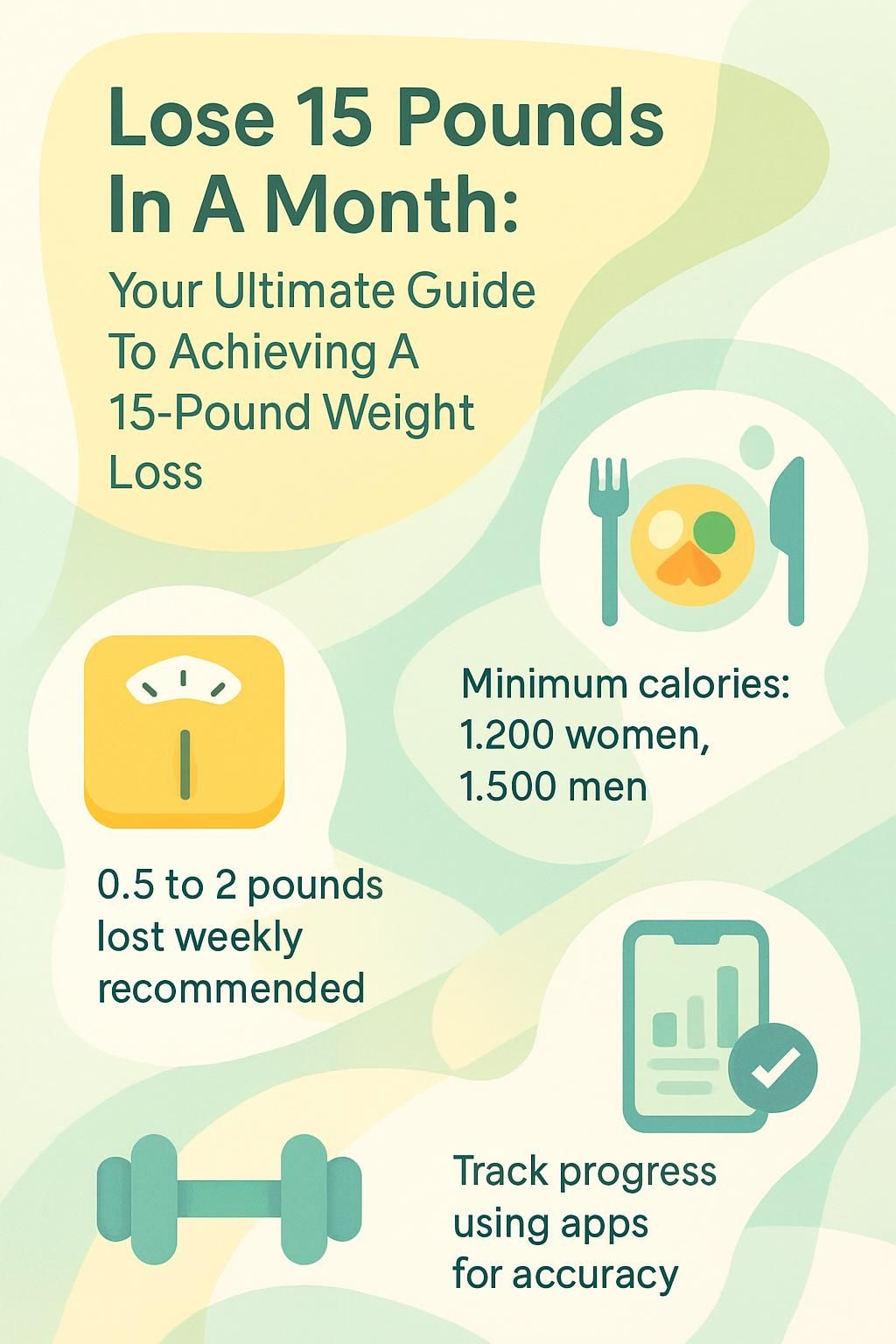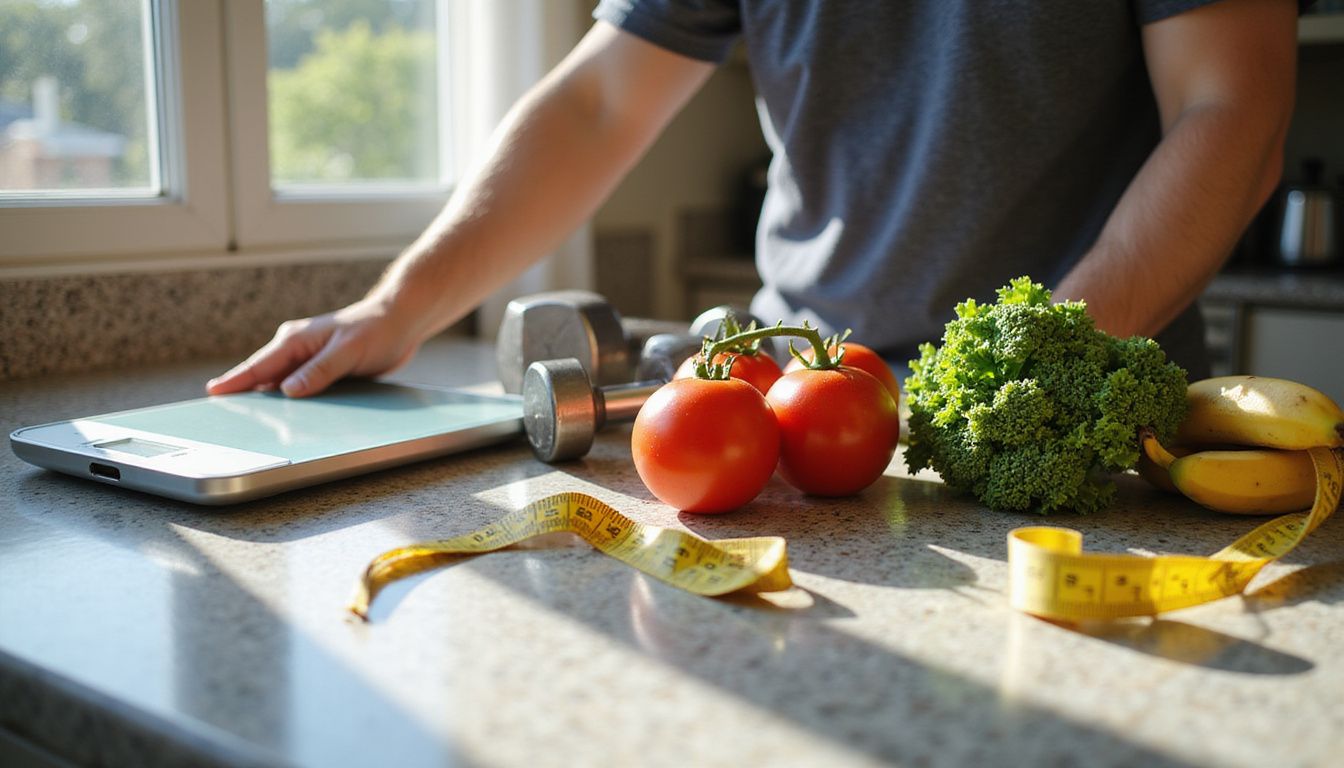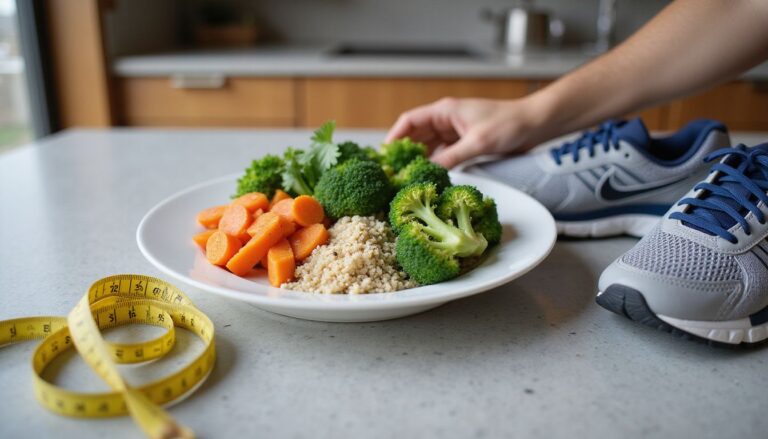Lose 15 Pounds In A Month: Your Ultimate Guide To Achieving A 15-Pound Weight Loss
Our Nutrition Assistant AI Suite will transform your body. You will lose fat, get toned, and build muscle. Gain confidence and optimal health.
You may want to lose 15 pounds in a month to improve health, energy, or confidence. Fast weight loss can be risky for some people, especially without a plan backed by science. This guide explains safe weight loss practices, gives clear diet and exercise steps, and helps you set a realistic weight loss goal with steady progress.
Key Takeaways
- Most experts suggest losing 0.5 to 2 pounds per week. Do not drop daily calorie intake below 1,200 for women, 1,350 for many nonbinary adults, or 1,500 for men.
- Rapid weight loss can cause muscle loss, nutrient gaps, and a slower metabolism. The American Heart Association links crash diets to risks such as arrhythmias and gallstones.
- Sustainable weight loss works best with a daily calorie deficit of about 500, regular cardio, strength training, and high-protein whole foods.
- People who use apps such as MyFitnessPal or Lose It! often lose more weight than those using paper logs, according to studies reported by Everyday Health.
- Talk with a healthcare professional before restrictive diets or intense exercise, especially if you have a health condition or take medications.

Is losing 15 pounds in a month safe?

Many people aim to lose weight quickly, yet trying to lose 15 pounds in a month is not safe for everyone. Understanding how weight management works, and the possible risks, helps you choose the best pace for your body.
What are the safe weight loss guidelines?
Health professionals, including Albert Matheny, R.D., C.S.C.S., recommend losing 0.5 to 2 pounds per week. A daily calorie deficit of about 500 usually leads to roughly 1 pound lost per week.
The Centers for Disease Control and Prevention and the National Institute of Diabetes and Digestive and Kidney Diseases note that gradual weight loss supports long-term success. It also lowers the chance of regaining weight later.
Daily calorie intake should generally not drop below 1,200 for women, 1,350 for nonbinary individuals, and 1,500 for men. USDA guidance shows many women maintain weight on 1,600 to 2,400 calories per day, while many men need 2,000 to 3,000.
In practice, a steady calorie deficit paired with whole grains, vegetables, and protein helps maintain energy. Following these guidelines reduces the risk of malnutrition and supports a safe path to your goal weight.
What are the risks of losing weight too quickly?
Extreme calorie cuts can trigger a starvation response. Metabolism slows, which makes long-term weight management harder. You may also lose muscle along with fat, which can reduce strength and daily energy.
Nutrient deficiencies are common with crash diets. Lacking iron, calcium, vitamin D, or potassium can lead to hair loss, fatigue, dizziness, irregular heartbeats, or digestive issues.
Rapid dieting often causes weight to return quickly. Peer-reviewed research cited by Everyday Health and the American Heart Association links fast shifts in human body weight to stress on the heart and kidneys; some people developed arrhythmias or gallstones within weeks.
“Rapid fat loss brings risks for both physical health and long-term success,” shares registered dietitian Jane Smith.
Large early drops on the scale often come from water weight, not true fat loss, which is hard to maintain.
How can I set realistic weight loss goals?
Clear goals keep you focused and reduce frustration. Align targets with your body weight, schedule, and activity level so your weight loss journey fits your life.
Why is sustainable weight loss important?
Slow, steady progress lowers risk and helps prevent rapid regain. Losing 5 to 7 percent of your current weight can reduce the chance of type 2 diabetes and improve blood pressure and cholesterol.
Better nutrition, such as eating more whole foods and less added sugar, supports health conditions like hypertension and obesity. Data from Lose It! users shows gradual progress helps keep weight off for good.
Aiming for one to two pounds per week is realistic. It protects muscle mass, lowers the risk of nutrient gaps, and supports habits you can keep.
How do I calculate my daily calorie deficit?
Weight loss requires a calorie deficit. The goal is to burn more than you consume, which allows your body to tap fat for energy.
- Find your Basal Metabolic Rate, or BMR. This is the calories you burn at rest. Use calculators that ask for age, sex, height, and weight.
- Add your activity level to estimate Total Daily Energy Expenditure, or TDEE. This includes daily movement and exercise.
- Subtract calories from your TDEE to create a deficit. Cutting 500 calories a day often leads to about 1 pound lost per week.
- Avoid very low intakes, under 1,200 to 1,300 for many women or 1,400 to 1,500 for many men. Too few calories can slow metabolism and increase nutrient risk.
- Log meals with a calorie tracking app. Accurate records make it easier to keep your daily calorie goal.
- Adjust based on results. If progress stalls, review calorie counts, portion sizes, and physical activity level.
- Many people find that tracking portions and staying consistent with meals lower in empty calories helps maintain energy while losing fat.
The role of diet in achieving weight loss
Your daily food choices drive how fast you lose weight. Smart changes improve digestion, energy, and week-to-week results.
Why focus on whole, unprocessed foods?
Whole foods such as fruit, vegetables, lean meat, and whole grains tend to be lower in calories and higher in dietary fiber than convenience food and soft drinks. Building meals around food groups and choosing produce for snacks helps you feel full on fewer calories.
These foods support vitamins and minerals your body needs for your brain, lungs, and digestion. They also limit trans fat, added sugar, and excess saturated fat found in candy and fast food.
Portion control becomes easier with whole foods. That makes it simpler to hold a safe calorie deficit and maintain a healthy diet.
How does portion control and mindful eating help?
Smaller servings reduce extra calories and support steady fat loss. Tools like MyPlate and digital tracking apps help you see true portion sizes.
Research shows app users often lose more weight than people who track by hand. Mindful eating, which means paying attention to hunger and fullness cues, also helps prevent overeating.
A simple example is eating from a smaller plate and pausing midway through a meal to check your fullness. Many people find they are satisfied with less food.
How can I reduce sugar and unhealthy fats?
Cutting added sugar and unhealthy fats can speed weight loss and improve health. Small daily changes compound over time.
- Swap sugary drinks for water, unsweetened tea, or sparkling water.
- Limit highly processed snacks such as baked goods, candy, chips, and ice cream.
- Read labels for added sugars like high-fructose corn syrup or cane juice.
- Choose whole grains over refined bread and pastries to boost fiber.
- Scale back fast food, which often contains high saturated fat and trans fat.
- Cook at home more often to control oils, butter, and added sugar.
- Use healthy fat sources like olive oil or avocados in moderation.
- Limit alcohol to up to one drink a day for women or two for men, and alternate with water.
- Avoid processed snacks made with refined carbohydrates and low-quality oils.
- Pick high-protein snacks to protect muscle mass and stay full longer.
- Track intake in an app to spot where sugar and excess fat add up.
What does a sample meal plan for weight loss look like?
A balanced plan keeps you full, supports nutrients, and maintains a calorie deficit. Here is one example day.
- Breakfast: Greek yogurt, fresh berries, and one ounce of walnuts. Protein and healthy fats help you stay satisfied.
- Lunch: Grilled chicken breast, brown rice, and steamed broccoli. Lean protein, fiber, and whole grains keep calories in check.
- Snack: Carrot sticks with two tablespoons of hummus. This offers minerals and controls hunger.
- Dinner: Baked salmon, quinoa, and roasted vegetables. Omega-3 fats, protein, and quality carbs aid recovery.
- Drinks: Water or unsweetened green tea to reduce added sugar.
- Dairy: Low-fat dairy or unsweetened plant milk to support calcium.
- Portions: Use a food scale or measuring cups for accuracy.
- Produce: Aim for at least five cups of fruits and vegetables each day.
- Protein: Target 20 to 30 grams of protein per meal to protect muscle.
- Evening snack: A small apple with almond butter to stabilize blood sugar.
The role of exercise in rapid weight loss
Exercise boosts calorie burn and helps maintain your body weight. Think of it as the spark that keeps your engine running strong.
Which cardio exercises burn the most calories?
Some cardio options burn many calories in a short time. Picking activities you enjoy makes consistency easier.
- Running at a moderate to fast pace can burn roughly 600 to 900 calories per hour, depending on speed and body weight.
- Jump rope hits many muscles and may burn up to 800 calories per hour. It also fits tight schedules.
- High-Intensity Interval Training, or HIIT, alternates hard efforts with short rests and can burn 500 to 750 calories per hour.
- Fast cycling or spin classes may burn 600 to 1,000 calories per hour for some adults. Building up to 150 minutes per week supports steady fat loss.
- Swimming uses the upper and lower body and often burns 400 to 700 calories per hour. It is gentle on joints.
- Rowing offers full-body work, around 500 to 700 calories per hour, while also building strength.
- Aerobic dance classes like Zumba usually burn 400 to 600 calories per class and can improve mood.
During my own cut, I raised my steps from about 3,000 to 8,000 a day. Then I added two HIIT sessions weekly with a trainer and saw faster results.
How does strength training preserve muscle mass?
Strength training uses resistance, like weights or your body weight, to challenge muscles. When you eat fewer calories, your body may break down muscle for energy. Lifting signals your body to keep muscle and use fat instead.
Studies show combining resistance training with a reduced-calorie diet protects lean body mass better than dieting alone. Clothes may fit looser even if the scale moves slowly, which reflects better body composition.
Protein intake matters too. A practical target is about 0.7 grams of protein per pound of body weight each day to support repair and growth.
Simple routines work. Squats, push-ups, and rows three times a week helped me keep strength and energy while losing weight.
What is High-Intensity Interval Training (HIIT) and why is it effective?
HIIT mixes short bursts of very hard effort with short rests or easier movement. For example, sprint 30 seconds, then walk 1 minute, and repeat several times.
Research suggests HIIT can burn similar calories in less time than steady cardio. One 2019 study found some 15-minute HIIT sessions matched an hour of jogging for energy use.
After a HIIT workout, your metabolism stays elevated for a while. That means extra calorie burn, which can speed fat loss when paired with a healthy diet and solid protein intake.
At home, I rotated bodyweight moves like burpees and mountain climbers. Short sessions fit busy days and still delivered results.
How to incorporate healthy lifestyle habits
Small daily habits drive big results. Think of them as your autopilot for consistent progress.
Why is staying hydrated important for weight loss?
Water helps control appetite and supports metabolism. Drinking before meals can reduce calories and help you stick to a low calorie plan.
Hydration also prevents mistaking thirst for hunger. I aimed for at least eight cups daily and noticed fewer late afternoon cravings.
Since water has zero calories, it fills your stomach without adding to your daily total. This makes it a simple win for any safe weight loss plan.
How does prioritizing sleep affect weight management?
Getting 7 or more hours of sleep supports recovery and better food choices. Poor sleep shifts hunger hormones, which can raise cravings and lower self-control.
With a full night of rest, many people report fewer sugary snack urges and more stable energy. Studies link short sleep with weight gain and trouble keeping weight off.
Sleep is a powerful lever. Use it to make healthy eating and exercise easier to maintain.
How can I manage stress and avoid emotional eating?
Stress can push you toward food for comfort. The goal is to pause, then choose a helpful action.
- Track stress triggers for a week. Note what sparks cravings and how it affects your eating.
- Practice deep breathing for five minutes during tense moments.
- Reach out to friends, family, or a healthcare provider for support.
- Write down your reasons to lose 15 pounds and keep them visible.
- Replace snacking with a short walk, a glass of water, or a calming hobby.
- Consider therapy or support groups if stress feels overwhelming.
- Practice mindful eating. Slow down and check hunger cues before more food.
- Set realistic goals. Losing 1 to 2 lbs per week is considered safe and sustainable.
- Protect sleep. Poor sleep raises stress hormones and appetite.
These habits prepare you to track progress with tools and apps in the next step.
What tools can I use to monitor my progress?
Tracking brings clarity. It shows what works, what does not, and how to adjust safely while trying to lose 15 pounds.
How do calorie tracking apps work?
Apps such as Lose It!, MyNetDiary, Nutritionix Track, MyFitnessPal, Calory, EasyFit, Cronometer, and FatSecret let you log meals by search or barcode scan. Each food shows calories and nutrients like protein, carbs, fat, and fiber.
These tools set goals using your age, gender, activity level, and a realistic weekly target. Studies summarized by Everyday Health show app users tend to lose more weight than handwritten trackers.
App feedback helps you spot patterns quickly. Many people find this easier and more accurate than guessing.
How should I track my physical activity and exercise?
Measuring activity keeps you accountable and makes it easier to stay consistent. Use tools you enjoy so the habit sticks.
- Use apps such as MyFitnessPal or Strava to log workouts and steps.
- Wear a fitness tracker for real-time data on calories, activity minutes, and heart rate zones.
- Prefer pen and paper? Record workout type, duration, intensity, and how you felt.
- Schedule workouts on your calendar like any appointment.
- Take quick photos or short videos to see progress in form and confidence.
- Track weekly minutes against CDC guidance of 150 minutes of moderate activity.
- Plan social activities that include movement for accountability and fun.
- Use body measurements and how clothes fit, not just the scale.
- Post a wall chart or checklist at home to see streaks grow.
- Review patterns weekly and keep what works, like higher step counts on planned workout days.
When I worked to lose 20 pounds, logging every workout and sharing weekly check-ins with friends kept me on track even on low-motivation days.
What are ways to measure progress beyond the scale?
Non-scale wins can drive motivation when the number stalls. They reflect changes your scale may miss.
- Measure waist, hips, arms, and thighs weekly. Inches can drop before pounds.
- Notice how clothes fit. Looser jeans are a clear sign of progress.
- Track endurance gains. Longer walks or faster runs signal better fitness.
- Watch sleep quality. Improved rest is a common win during weight loss.
- Note energy and mood. Balanced nutrition and steady minerals can boost both.
- Journal confidence and focus. Many people feel calmer and more motivated.
- Celebrate actions, like cooking a healthy meal or skipping sugary snacks.
I logged running pace daily and saw faster recovery. That kept me going even during plateaus.
How do I overcome common weight loss challenges?
Roadblocks will happen. With a plan, you can push through and keep losing weight safely.
How can I handle weight loss plateaus?
Plateaus are normal. They usually mean your body adapted to your current plan.
- Recheck your food log to find hidden calories or portion creep.
- Trim 100 to 200 calories per day if progress stalls for more than a week.
- Increase workout intensity or add minutes to raise calorie burn.
- Change your routine. Try new cardio or add strength training.
- Get 7 or more hours of sleep to support recovery and appetite control.
- Drink at least eight cups of water daily to support metabolism.
- Manage stress with short walks or deep breathing to curb cravings.
- Track non-scale wins like stamina or looser clothing for motivation.
I hit a plateau after losing ten pounds in three weeks. Smaller portions and a 20-minute evening walk helped me move forward again.
What strategies help with emotional or stress eating?
Emotional eating can slow progress. Use targeted tactics to regain control.
- Keep a food and mood journal to spot patterns between feelings and eating.
- Use deep breathing or relaxation exercises before grabbing a snack.
- Talk with a friend, family member, or therapist when stress spikes.
- Create non-food rewards like a walk, music, or a short reading break.
- Keep trigger foods out of reach and stock healthy options.
- Plan regular meals and snacks to avoid extreme hunger.
- Ask yourself why you want to eat. Boredom, stress, or habit often drive cravings.
Stress management protects your plan and your results.
How do I stay motivated during my weight loss journey?
Motivation comes and goes. Use simple systems to keep going during tough weeks.
Place your reasons for change where you can see them, like sticky notes or phone reminders. Celebrate small wins, such as every 1 or 2 pounds lost, with non-food rewards like a new book or a walk with a friend.
Track progress in a journal or app. The National Weight Control Registry reports that regular tracking supports long-term success. If motivation dips, review past wins and adjust your next small step.
Specific strategies for faster weight loss results
Some methods can help you reach your weight loss goal a bit faster. Use them wisely and check in with your healthcare provider if you have concerns.
What are effective intermittent fasting methods?
Intermittent fasting reduces your eating window so it is easier to eat fewer calories. Many find it practical for busy schedules.
- 16/8 method: Eat within an 8-hour window and fast for 16 hours. Research from 2020 shows it is popular and can be effective.
- Alternate-day fasting: Rotate fasting days with normal eating days. This can create a larger calorie gap each week.
- 5:2 approach: Eat normally five days a week and limit to about 500 to 600 calories on two nonconsecutive days.
- Spontaneous meal skipping: If you are not hungry, skip a meal. This flexible style suits some people.
- Consult a healthcare professional or registered dietitian before fasting, especially if you take medications or have a condition.
- Track intake with an app during fasting to stay within your calorie goals.
- Stay hydrated with water, herbal tea, or black coffee during fasting hours.
I used 16/8 for two months. After the first week, hunger settled and I snacked less during the day.
How do low-carb or ketogenic diets work for weight loss?
Low-carb and ketogenic diets limit daily carbohydrate intake, often under 50 grams. This can shift your body into ketosis, a state where it burns stored fat for energy.
Many people see early drops in water weight, then steady fat loss. Feeling fuller from higher fat and protein may reduce calories without much effort.
Some studies report 2 to 10 pounds lost in the first week, though results vary. These diets can create nutrient gaps if not planned well, so discuss them with your healthcare provider.
When should I consult a healthcare professional about medications or supplements?
Weight loss medications require medical supervision. They are intended for people who meet specific criteria, such as those with obesity or related conditions.
Talk with your primary care physician or a registered dietitian if you are considering medications or supplements. Some supplements interact with prescriptions or affect heart, liver, or kidney health.
Professional guidance reduces side effects and keeps your plan safe while working toward a 15-pound weight loss.
Precautions to consider during weight loss
Careful choices lower health risks and support steady progress. Think safety first, then speed.
Why avoid extreme or fad diets?
Fad diets often cause fast drops in weight, mostly from water and muscle. They may cut out entire food groups or push very low calories, which raises the risk of dehydration and nutrient gaps.
Researchers warn that rapid weight loss can strain the heart, liver, and kidneys. The CDC recommends losing 1 to 2 pounds per week for a safer approach.
Since most people regain lost weight after a fad diet, sustainable habits are the smarter choice. Before major changes, review your plan with a healthcare professional.
What are signs of nutrient deficiencies to watch for?
Rapid weight loss and very low intake can lead to nutrient shortages. Watch for these common warning signs and take action early.
- Fatigue or weakness, often linked to low iron or vitamin B12.
- Hair loss, which can result from low protein, zinc, or iron.
- More frequent colds, possibly due to low vitamins A, C, or D.
- Dry skin or brittle nails, sometimes caused by low healthy fats, vitamin E, or biotin.
- Muscle cramps or tingling, which may signal low calcium, magnesium, or potassium.
- Mood swings or low mood, sometimes tied to low omega-3 fats or B vitamins.
- Slow wound healing, which can reflect low protein or vitamin C.
- Mouth sores or cracks, often due to low B vitamins such as riboflavin or niacin.
When is it time to see a doctor or dietitian?
Sudden or unexplained weight loss, especially after age 65, needs medical attention. It can signal conditions like diabetes, cancer, or thyroid problems.
Other signs include ongoing fatigue, weakness, appetite changes, or mood shifts. A registered dietitian can find nutrient gaps and help you build a safe eating plan.
Early care matters. Quick action helped my father get a treatable diagnosis after losing ten pounds unexpectedly at age 72.
Tips for long-term weight loss maintenance
Keeping weight off is a skill. With the right habits, you can protect your hard-earned results for years.
How do I transition to a balanced diet after weight loss?
Moving from a deficit to maintenance requires patience. Gradual changes protect your progress and your metabolism.
- Raise daily calories slowly over two to four weeks, guided by a tracking app.
- Include all food groups: lean proteins, whole grains, fruits, vegetables, and healthy fats.
- Prioritize nutrient-dense foods like leafy greens, legumes, and nuts.
- Limit high-sugar snacks and heavily processed foods linked to weight regain.
- Balance macronutrients, for example 30% protein, 30% healthy fat, and 40% carbohydrates, based on your needs.
- Use smaller plates and listen to hunger cues to prevent overeating.
- Weigh in weekly. Make small adjustments if weight starts to rise.
- Keep healthy snacks handy, such as fruit or Greek yogurt.
- Stick to regular meal timing, like three meals and one or two planned snacks.
- Consult a registered dietitian or doctor if you notice fatigue, hair loss, or other signs of nutrient issues.
What makes a sustainable exercise routine?
Put workouts on your calendar like appointments to improve adherence. A 2022 study in the Journal of Behavioral Medicine found people who schedule exercise are more likely to stick with it.
Choose activities you enjoy, such as biking, swimming, or dancing. Variety helps too. For example, do cardio on Monday, strength on Wednesday, and yoga on Friday to reduce boredom and injury risk.
Rotating activities kept me engaged and helped me reach fitness goals faster. Build a routine that supports your new lifestyle.
How can I prevent regaining lost weight?
Track weight and food weekly so you can catch small gains early. Maintain core habits: drink water, sleep at least 7 hours, and manage stress.
Consider a support group or a healthcare professional for accountability. If weight rises by more than 2 pounds in two weeks, adjust calories or increase activity right away.
Conclusion
Reaching a 15-pound weight loss in a month takes planning, patience, and care. Focus on whole foods, a consistent calorie deficit, and a mix of cardio and strength training. Set realistic goals, track your progress, and work with a healthcare professional if you have a health condition or need guidance. With steady effort and smart choices, you can make meaningful progress and protect your health.
FAQs
1. Is it safe to lose 15 pounds in a month?
Losing 15 pounds in one month is not safe for most people. Health experts recommend losing one to two pounds per week. Rapid weight loss can cause muscle loss, fatigue, and nutritional deficiencies. A study from the Centers for Disease Control and Prevention supports gradual weight reduction for lasting results.
2. What diet changes help achieve a 15-pound weight loss?
Eating fewer calories than you burn is key. Focus on lean protein like chicken or fish, whole grains such as brown rice or oats, fruits like apples or berries, and vegetables including spinach or broccoli. Limit processed foods high in sugar and fat. Tracking your meals with an app helps many people stay on target.
3. How much exercise do I need to lose 15 pounds in four weeks?
Aim for at least 150 minutes of moderate aerobic activity each week along with strength training twice weekly according to guidelines from the American Heart Association. Walking briskly, swimming laps, cycling at moderate speed, or using resistance bands all support calorie burning.
4. Can personal experience support these strategies?
Yes; when I followed a structured meal plan rich in vegetables and lean protein while walking daily for thirty minutes, I lost eight pounds over four weeks without feeling deprived. Consistent habits made it easier to maintain progress over time.
Summary: Losing fifteen pounds in thirty days is not recommended by health authorities due to risks of rapid weight reduction. Gradual changes that combine balanced nutrition with regular activity are safer and more effective long term according to research data and personal experience alike.







